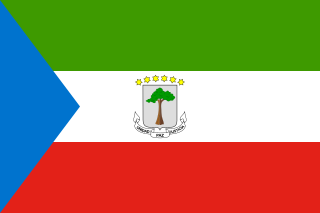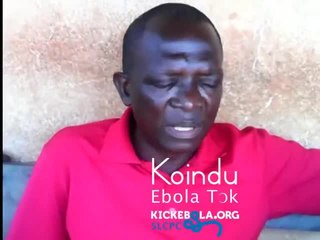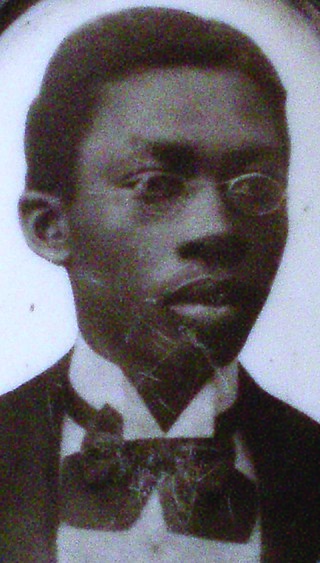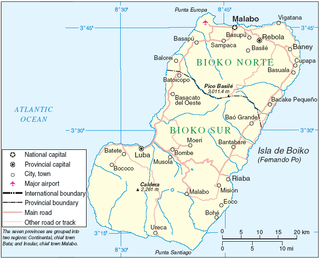Related Research Articles

Equatorial Guinea, officially the Republic of Equatorial Guinea, is a country on the west coast of Central Africa, with an area of 28,000 square kilometres (11,000 sq mi). Formerly the colony of Spanish Guinea, its post-independence name refers to its location near both the Equator and in the African region of Guinea. As of 2021, the country had a population of 1,468,777, over 85% of whom are members of the Fang people, the country's dominant ethnic group. The Bubi people, indigenous to Bioko, are the second largest group at approximately 6.5% of the population.

The History of Equatorial Guinea is marked by centuries of colonial domination by the Portuguese, British and Spanish colonial empires, and by the local kingdoms.

Demographic features of the population of Equatorial Guinea include population density, ethnicity, education level, health of the populace, economic status, religious affiliations and other aspects of the population.

Malabo is the capital of Equatorial Guinea and the province of Bioko Norte. It is located on the north coast of the island of Bioko. In 2018, the city had a population of approximately 297,000 inhabitants.

A Spanish creole, or Spanish-based creole language, is a creole language for which Spanish serves as its substantial lexifier.

The Bubi people are a Bantu ethnic group of Central Africa who are indigenous to Bioko Island, Equatorial Guinea. Once the majority group in the region, the population experienced a sharp decline due to war and disease during Portuguese expeditions. By the end of Spanish colonial rule in the mid 20th century, and after substantial intermarriage with newly introduced populations, such as Afro-Cubans, Krio people, Portuguese people and Spaniards, the Bubi people, again, experienced a great decline in number. Seventy-five percent perished due to tribal/clan rooted political genocide during a civil war that led to Spanish Guinea's independence from Spain. This, too, sparked mass exodus from their homeland with most of the exiles and refugees immigrating into Spain. The indigenous Bubi of Bioko Island have since co-existed with non-indigenous Krio Fernandinos; and members of the Fang ethnic group, who have immigrated in large numbers from Río Muni. Once numbering approximately 3 million, the Bubi currently number around 100,000 worldwide.

Spanish Guinea was a set of insular and continental territories controlled by Spain from 1778 in the Gulf of Guinea and on the Bight of Bonny, in Central Africa. It gained independence in 1968 as Equatorial Guinea.

Sherbro Island is in the Atlantic Ocean, and is included within Bonthe District, Southern Province, Sierra Leone. The island is separated from the African mainland by the Sherbro River in the north and Sherbro Strait in the east. It is 32 miles (51 km) long and up to 15 miles (24 km) wide, covering an area of approximately 230 square miles (600 km2). The western extremity is Cape St. Ann. Bonthe, on the eastern end, is the chief port and commercial centre.

The Sierra Leonean Creole or Krio is an English-based creole language that is lingua franca and de facto national language spoken throughout the West African nation of Sierra Leone. Krio is spoken by 96 percent of the country's population, and it unites the different ethnic groups in the country, especially in their trade and social interaction with each other. Krio is the primary language of communication among Sierra Leoneans at home and abroad, and has also heavily influenced Sierra Leonean English. The language is native to the Sierra Leone Creole people, or Krios, a community of about 104,311 descendants of freed slaves from the West Indies, Canada, United States and the British Empire, and is spoken as a second language by millions of other Sierra Leoneans belonging to the country's indigenous tribes. Krio, along with English, is the official language of Sierra Leone.
Fernão do Pó, also known as Fernão Pó, Fernando Pó or Fernando Poo, was a 15th-century Portuguese navigator and explorer of the West African coast. He was the first European to see the islands in the Gulf of Guinea around 1472, one of which until the mid-1900s bore a version of his name, Fernando Pó or Fernando Poo. The island is now named Bioko and is part of Equatorial Guinea. His name had also been given to several other places in nearby Cameroon; the village of Fernando Pó, Portugal; and the village of Fernando Pó, Sierra Leone.
West African Pidgin English, also known as Guinea Coast Creole English, is a West African pidgin language lexified by English and local African languages. It originated as a language of commerce between British and African slave traders during the period of the transatlantic slave trade. As of 2017, about 75 million people in Nigeria, Cameroon, Ghana and Equatorial Guinea used the language.

William Napoleon Barleycorn (1848–1925), born in Santa Isabel, Fernando Po, Spanish Guinea and a Krio Fernandino of Igbo descent, was a Primitive Methodist missionary who went to Fernando Po in Africa in the early 1880s. From there, he travelled to Edinburgh University.
Equatoguinean Spanish is the variety of Spanish spoken in Equatorial Guinea. This is the only Spanish variety that holds national official status in Sub-Saharan Africa. It is regulated by the Equatoguinean Academy of the Spanish Language and is spoken by about 90% of the population, estimated at 1,170,308 for the year 2010, all of them second-language speakers.

Pichinglis, commonly referred to by its speakers as Pichi and formally known as Fernando Po Creole English (Fernandino), is an Atlantic English-lexicon creole language spoken on the island of Bioko, Equatorial Guinea. It is an offshoot of the Krio language of Sierra Leone, and was brought to Bioko by Krios who immigrated to the island during the colonial era in the 19th century.

The Spanish diaspora in Equatorial Guinea is made of people of Spanish descent who are residents born or living in Equatorial Guinea. The population from Spain living in Equatorial Guinea numbers an estimated 17,000. This group is closely linked with the Fernandino people, a creole people who developed Spanish Guinea and Equatorial Guinea, mostly in Bioko island.

William Allen Vivour was the single most successful 19th-century planter in Africa due to his substantial and flourishing cocoa plantation in Fernando Po. He was the son of a recaptive of Yoruba ancestry and resettled in Sierra Leone by the British West Africa Squadron, and eventually settled in present day Equatorial Guinea and Nigeria.
Maximiliano Cipriano Jones (1871–1944) was a Fernandino who became the richest black planter of the island Fernando Po, Spanish Guinea in 1929.
Sierra Leonean Americans are an ethnic group of Americans of full or partial Sierra Leonean ancestry. This includes Sierra Leone Creoles whose ancestors were African American Black Loyalists freed after fighting on the side of the British during the American Revolutionary War. Some African Americans trace their roots to indigenous enslaved Sierra Leoneans exported to the United States between the 18th and early 19th century. In particular, the Gullah people of partial Sierra Leonean ancestry, fled their owners and settled in parts of South Carolina, Georgia, and the Sea Islands, where they still retain their cultural heritage. The first wave of Sierra Leoneans to the United States, after the slavery period, was after the Sierra Leone Civil War in the 1990s and early 2000s. According to the American Community Survey, there are 34,161 Sierra Leonean immigrants living in the United States.

The Sierra Leone Creole people are an ethnic group of Sierra Leone. The Sierra Leone Creole people are descendants of freed African-American, Afro-Caribbean, and Liberated African slaves who settled in the Western Area of Sierra Leone between 1787 and about 1885. The colony was established by the British, supported by abolitionists, under the Sierra Leone Company as a place for freedmen. The settlers called their new settlement Freetown. Today, the Sierra Leone Creoles are 1.2 percent of the population of Sierra Leone.

Bioko is an island 32 km (20 mi) south of the coast of Cameroon, and 160 km (99 mi) northwest of the northernmost part of mainland Equatorial Guinea. Malabo, on the north coast of the island, is the capital city of Equatorial Guinea. Its population was 335,048 at the 2015 census and it covers an area of 2,017 km2 (779 sq mi). The island is part of the Cameroon line of volcanoes and is located off the Cameroon coast, in the Bight of Biafra portion of the Gulf of Guinea. Its geology is volcanic; its highest peak is Pico Basile at 3,012 m (9,882 ft).
References
- ↑ [W. G. Clarence-Smith, "African and European Cocoa Producers on Fernando Póo, 1880s to 1910s," The Journal of African History, Volume 35, Issue 02, July 1994, pp 179–199, doi : 10.1017/S0021853700026384, Published online by Cambridge University Press 22 January 2009.
- ↑ I. K. Sundiata, From Slaving to Neoslavery: The Bight of Biafra and Fernando Po in the Era of Abolition, 1827–1930; Univ of Wisconsin Press, 1996; ISBN 0-299-14510-7, ISBN 978-0-299-14510-1; p.152
- ↑ Glimpses of Africa, West and Southwest coast. By Charles Spencer Smith; A.M.E. Sunday School Union, 1895; p. 164
- ↑ Sundiata, I. K. (1966). From Slaving to Neoslavery: The Bight of Biafra and Fernando Po in the Era of Abolition, 1827-1930. Wisconsin: University of Wisconsin Press. p. 152. ISBN 978-0-299-14510-1 . Retrieved 25 September 2016.
- ↑ Glimpses of Africa, West and Southwest coastBy Charles Spencer Smith; A.M.E. Sunday School Union, 1895